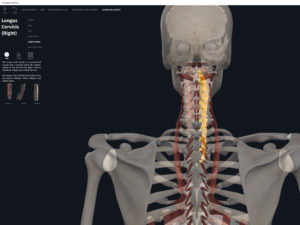Anatomy & Physiology: Muscles—Longus Colli.
Structure.
- Superior Oblique
- Origin: transverse process of C3-C5.
- Insertion: anterior arch of C1.
- Inferior Oblique
- Origin: anterior bodies of T1-T3.
- Insertion: transverse processes of C5-C6.
- Vertical
- Origin: anterior bodies of C5-T3.
- Insertion: anterior bodies C2-C4.
Function.
- Concentric action: neck flexion, lateral flexion, contralateral rotation.
- Reverse mover action: flexion, lateral flexion, and ipsilateral rotation of neck and upper back.
- Eccentric action: controls/restrains/slows extension and contralateral later flexion of neck; ipsilateral rotation of neck; contralateral rotation of neck and upper back.
- Isometric action: stabilization of cervical and upper thoracic spine.
- Innervation: cervical spinal nerves.
- Arterial supply: inferior thyroid artery, vertebral artery, ascending pharyngeal artery.
Clinical Significance.
References
Biel, A. (2015). Trail guide to the body: A hands-on guide to locating muscles, bones and more.
Cedars-Sinai. (2018). Vertebrae of the spine. Retrieved from https://www.cedars-sinai.org/health-library/diseases-and-conditions/v/vertebrae-of-the-spine.html
Clark, M., Lucett, S., Sutton, B. G., & National Academy of Sports Medicine. (2014). NASM essentials of corrective exercise training. Burlington, MA: Jones & Bartlett Learning.
Jenkins, G., & Tortora, G. J. (2012). Anatomy and Physiology: From Science to Life, 3rd Edition International Stu. John Wiley & Sons.
Muscolino, J. E. (2017). The muscular system manual: The skeletal muscles of the human body.

